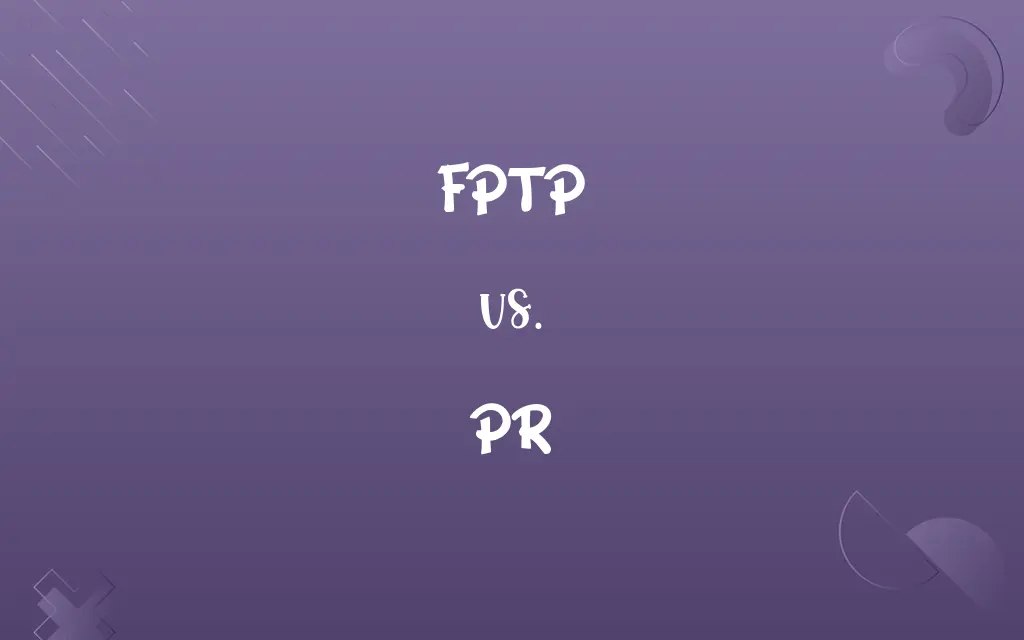FPTP vs. PR: Know the Difference

By Shumaila Saeed || Published on February 16, 2024
FPTP (First Past the Post) is a simple plurality voting system where the candidate with most votes wins; PR (Proportional Representation) allocates seats based on the proportion of votes each party receives.

Key Differences
FPTP, or First Past the Post, is a voting system where the candidate with the most votes in a constituency wins, regardless of whether they achieve a majority. PR, or Proportional Representation, aims to allocate seats in the legislature in proportion to the votes each party receives, reflecting a more diverse range of political opinions.
Shumaila Saeed
Feb 16, 2024
In FPTP, the focus is on individual candidates in single-member districts, leading to a direct connection between voters and their representatives. PR, conversely, often uses multi-member districts or party lists, focusing more on parties and their overall support across a broader electorate.
Shumaila Saeed
Feb 16, 2024
FPTP tends to favor larger parties and can lead to majority governments, but it may also result in a significant number of votes not contributing to seat allocation. PR systems, in contrast, are more inclusive of smaller parties and typically result in coalition governments, better representing minority interests.
Shumaila Saeed
Feb 16, 2024
FPTP is simpler and provides clear results, often making it easier for voters to understand. However, it can lead to the 'winner-takes-all' phenomenon. PR systems are more complex but are praised for their fairness in representing diverse political views, though they can lead to fragmented parliaments.
Shumaila Saeed
Feb 16, 2024
The choice between FPTP and PR reflects a trade-off between simplicity and direct representation (FPTP) versus complexity and broader representation (PR). Each system has its advantages and drawbacks, influencing how democracies function and how well they represent their constituents.
Shumaila Saeed
Feb 16, 2024
ADVERTISEMENT
Comparison Chart
Basic Mechanism
Candidate with most votes in a district wins
Seats allocated in proportion to party's vote share
Shumaila Saeed
Feb 16, 2024
Constituency Representation
Single-member districts
Multi-member districts or party lists
Shumaila Saeed
Feb 16, 2024
Favorability
Favors larger parties, majority governments
Inclusive of smaller parties, coalition governments
Shumaila Saeed
Feb 16, 2024
Complexity
Simpler, easier for voters to understand
More complex, represents diverse political views
Shumaila Saeed
Feb 16, 2024
Representation Outcome
Can ignore minority opinions
Better reflects a range of political opinions
Shumaila Saeed
Feb 16, 2024
ADVERTISEMENT
FPTP and PR Definitions
FPTP
A voting system where the candidate with the most votes in a district wins.
In the FPTP system, Candidate A won the seat by securing the highest number of votes in the district.
Shumaila Saeed
Jan 24, 2024
PR
Encourages multi-party systems and coalition governments.
The PR electoral system has led to a diverse parliament with several coalition governments.
Shumaila Saeed
Jan 24, 2024
FPTP
Can lead to strategic voting to prevent a less preferred candidate's win.
Voters often choose the lesser of two evils in an FPTP election to avoid splitting the vote.
Shumaila Saeed
Jan 24, 2024
PR
Aimed at accurately reflecting the voters' preferences in the legislature.
PR ensures that even smaller parties have representation in the government, mirroring public opinion.
Shumaila Saeed
Jan 24, 2024
FPTP
Used in countries like the UK and USA for legislative elections.
The FPTP system is a hallmark of the electoral process in the United Kingdom.
Shumaila Saeed
Jan 24, 2024
ADVERTISEMENT
PR
Can be implemented through party-list or mixed-member systems.
The country adopted a mixed-member PR system to balance constituency representation and party proportionality.
Shumaila Saeed
Jan 24, 2024
FPTP
Simplifies elections, but may not reflect the overall popular vote.
Despite winning the popular vote, the party lost in the FPTP electoral system.
Shumaila Saeed
Jan 24, 2024
PR
Allocates legislative seats in proportion to the votes each party receives.
Under the PR system, the party received 20% of the votes and therefore 20% of the parliamentary seats.
Shumaila Saeed
Jan 24, 2024
FPTP
Often leads to a two-party system due to its winner-takes-all nature.
The FPTP system has historically favored the two dominant political parties in our country.
Shumaila Saeed
Jan 24, 2024
PR
Often results in higher voter turnout due to its inclusiveness.
The inclusive nature of the PR system has historically resulted in higher levels of voter participation.
Shumaila Saeed
Jan 24, 2024
PR
A soft yellowish-white trivalent metallic element of the rare earth group; can be recovered from bastnasite or monazite by an ion-exchange process
Shumaila Saeed
Jan 22, 2024
PR
A self-governing commonwealth associated with the United States occupying the island of Puerto Rico
Shumaila Saeed
Jan 22, 2024
Repeatedly Asked Queries
What does PR stand for?
Proportional Representation, a system allocating seats based on vote share.
Shumaila Saeed
Feb 16, 2024
How does FPTP affect political parties?
FPTP often leads to a dominance of larger parties and a two-party system.
Shumaila Saeed
Feb 16, 2024
Is FPTP fair in representation?
FPTP can be seen as less fair as it may not reflect the overall popular vote.
Shumaila Saeed
Feb 16, 2024
Does PR complicate the voting process?
PR can be more complex than FPTP, but it varies by the specific system used.
Shumaila Saeed
Feb 16, 2024
What does FPTP stand for?
First Past the Post, a simple plurality voting system.
Shumaila Saeed
Feb 16, 2024
Does PR lead to stable governments?
PR often leads to coalition governments, which can be stable but sometimes less decisive.
Shumaila Saeed
Feb 16, 2024
Which countries use PR?
Many European countries, including Germany and Spain, use forms of PR.
Shumaila Saeed
Feb 16, 2024
Does PR increase voter turnout?
Often, yes, as it gives voters a sense that all votes matter.
Shumaila Saeed
Feb 16, 2024
How does FPTP impact election outcomes?
FPTP can result in 'winner-takes-all' outcomes, often ignoring minority views.
Shumaila Saeed
Feb 16, 2024
Are smaller parties favored by PR?
Yes, PR is more inclusive of smaller parties.
Shumaila Saeed
Feb 16, 2024
How does PR impact legislative diversity?
PR usually leads to a more diverse and representative legislature.
Shumaila Saeed
Feb 16, 2024
Can FPTP result in a majority government?
Yes, FPTP is more likely to produce majority governments.
Shumaila Saeed
Feb 16, 2024
Which countries use FPTP?
Countries like the UK, USA, and Canada use FPTP for legislative elections.
Shumaila Saeed
Feb 16, 2024
Can FPTP distort the popular vote?
Yes, FPTP can lead to a government not reflecting the popular vote.
Shumaila Saeed
Feb 16, 2024
Is PR better for democracy?
Some argue PR is more democratic as it reflects a wider range of opinions.
Shumaila Saeed
Feb 16, 2024
How do constituencies work in FPTP?
In FPTP, each constituency elects one representative.
Shumaila Saeed
Feb 16, 2024
Is FPTP easier to understand for voters?
Generally, yes, FPTP is more straightforward.
Shumaila Saeed
Feb 16, 2024
Are coalitions common under PR?
Yes, coalition governments are common in PR systems.
Shumaila Saeed
Feb 16, 2024
Can FPTP lead to wasted votes?
Yes, votes for losing candidates in FPTP are often considered 'wasted'.
Shumaila Saeed
Feb 16, 2024
How are votes counted in PR?
In PR, votes are counted to reflect the overall support for each party.
Shumaila Saeed
Feb 16, 2024
Share this page
Link for your blog / website
HTML
Link to share via messenger
About Author
Written by
Shumaila SaeedShumaila Saeed, an expert content creator with 6 years of experience, specializes in distilling complex topics into easily digestible comparisons, shining a light on the nuances that both inform and educate readers with clarity and accuracy.









































































